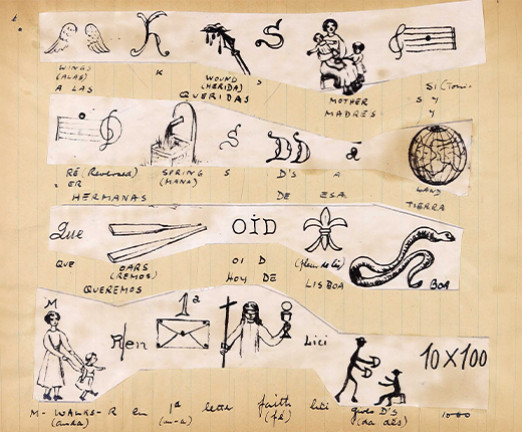
Censorship: Policy and Practice During the Second World War

The work of the Censorship is of a highly confidential nature and must on no account be discussed outside the rooms in which it is actually carried onDEFE 1/36/11
Access the full collection
Access the full archive of Censorship: Policy and Practice During the Second World War.
Institutional Free Trial
Start your free trialRegister for a free 30-day trial of Censorship: Policy and Practice During the Second World War, for your institution.
Institutional Sales
Visit Sales PagesellFor more information on institutional access, visit our sales page.
Already have a license? Sign in.
Uncover hidden aspects of the Second World War through the eyes of government censors


Censorship: Practice and Policy during the Second World War explores British postal and telegraph censorship throughout a pivotal era of modern history. The collection contains over 17,000 images drawn from Ministry of Defence files at The National Archives. It begins by surveying the first tentative steps that were taken, following the outbreak of conflict in 1939, to implement and to co-ordinate censorship. Documents reveal how hastily-assembled censorship teams looked back to the First World War for lessons and instructional precedents whilst adapting to the major technological developments that had occurred since. The work undertaken by censorship units—which necessitated keeping a close eye on all communications that could reveal sensitive or dangerous information to the enemy—soon became one of the most important, if somewhat underappreciated, fronts in the so-called “secret war”.
Censorship became a wide-ranging, international endeavour. It involved not just Britain, but also the Dominions, colonies, allies (including the USA), and neutral states such as Ireland. Censorship teams sprung up across the globe, typically employing local people, especially women. They worked round the clock, ensuring that all correspondence was assessed, flagged (if necessary), and passed on swiftly. Policies, instructions, and official guidance poured out from London with a view to keeping the censorship system efficient and watertight. Censors from a wide variety of backgrounds became adept at breaking codes and recognising suspect material, even if it was cleverly concealed.
Towards the end of the war and following the Allied victory, censorship units took on a new responsibility: monitoring communications amongst the populations in occupied territories, including Austria, Germany, and Italy. This was not merely a security measure; it also provided an important barometer of public morale—a way of appraising the attitudes of former enemy civilians. As this fascinating collection illustrates, censorship was not only a tool that helped win the war, it was also a vital part of securing the peace which followed.
This collection is a rich resource for students and researchers with interests in military and political history, the history of the British empire, international relations, and security and intelligence.
Contents
Censorship: Policy and Practice During the Second World War...
Discover
Highlights

Licensed to access DEFE 1/209 - Overseas Censorship: Inspections of Caribbean Censorship Stations
The war necessitated a concerted effort to educate people in Britain and throughout the empire on censorship policy. This document (image 542), issued in Trinidad, warns people that “all written, printed, photographic, and recorded material you may wish to take out of the Colony MUST be censored”.

Licensed to access DEFE 1/211 - Overseas Censorship: United States Censorship Procedures and Publications
Innovative ways to evade censorship were always being developed. This document (images 46–55) reveals how Japanese prisoners of war created codes, based on anagrams, to convey information about their conditions and treatment.

Licensed to access DEFE 1/398 - Reports on Civil Censorship in Austria and Germany
Towards the end of the war, and following the Allied victory, censorship was geared increasingly towards gauging public opinion in former enemy territories. This document (images 16–30) considers Austrian responses to the British occupation. It surveys people’s feelings on wages and the availability of food, as well as attitudes towards the British and Nazism.

Licensed to access DEFE 1/160 - Overseas Reports: Report on the Jamaica Censorship Station
Spanning its empire, Britain’s censorship network was vast. It generated employment for local communities, particularly for women. Unfortunately, censorship offices were not devoid of gender and racial tensions. This report (images 10–23) recommends that further staff appointments to the Jamaica office should be “British-born” and “supplied from outside the island”.
Insights
The creation of an effective censorship network was a significant logistical undertaking for Britain’s war-time government. Censorship offices had to be designed, constructed, furnished, and, crucially, staffed, across the empire. All of this generated a hefty administrative paper-trail, which this collection showcases. It contains blueprints for, and images of, censorship buildings in Trinidad; designs for sorting tables used in censorship offices; and progress reports on the development of censorship infrastructure penned by British officials.
Ensuring that staff were properly briefed on, and trained in-line with, censorship policy was of the utmost importance to the British government. Indeed, the rapid expansion of the wartime censorship network across the breadth of the empire meant that censorship offices frequently employed local people, many of whom had no previous experience in this field. This collection provides numerous examples of the rigorous official guidance and technical training documents that were relayed to censors throughout Britain and beyond.
Although Britain established its own extensive network, censorship was, by its very nature, a co-operative endeavour. As many documents in this collection illustrate, Britain’s censorship department worked closely with its Allied counterparts, such as the United States, as well as with the neutral Republic of Ireland, with which it shares a border.
A good deal of time and thought was given over to comprehending how censorship was operating in enemy states as well as in Allied territories. For example, the collection contains maps of German postal districts and guides to censorship stamps used in Nazi Germany, Vichy France, and Japan. There are also official documents explaining how censorship practices varied in areas under Nazi rule and detailing censorship instructions that were issued to the public throughout the Third Reich.
Ultimately, careful thought had to be given as to how Britain’s elaborate censorship system was to be wound-down. This was a tricky process, not least because it had to harmonise with post-war censorship practices and timetables adopted by Allied states, especially the US. Precisely how censorship was to operate in recently occupied territories, such as Germany and Japan, and how long it would last, were also among the tough questions facing British officials in the wake of victory.
Unlock Historical Research for Your Institution
Provide your students and researchers with direct access to unique primary sources.
Related Media









.svg)

